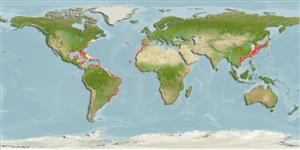分类 / Names
俗名 | 同种异名 | Catalog of Fishes(属, 种) | ITIS | CoL | WoRMS | Cloffa
Elasmobranchii
板鳃亚纲 (鲨鱼与 鱼) (sharks and rays) >
Squaliformes (Sleeper and dogfish sharks)
棘鮫目 (Sleeper and dogfish sharks) >
Dalatiidae (Sleeper sharks)
黑鮫科 (Sleeper sharks)
Etymology: Isistius: Etymology not explained, probably iso-, from isos (Gr.), equal; istius, from histion (Gr.), sail (i.e., dorsal fin), referring to its two similarly shaped and sized (and posterior) dorsal fins, a character Gill used to diagnose genus. José I. Castro, The Sharks of North America (Oxford University Press, 2011), suggests name may allude to the Egyptian goddess Isis, represented in statuary with her head veiled, or to the dark collar encircling throat of I. brasiliensis, “which could also suggest a veil over the head” (p. 145). This interpretation is rejected by the fact that Gill often used “istius” in the names of several genera distinguished (at least in part) by their dorsal fins (Acanthistius, Brachyistius, Caristius, Dichistius, Goniistius, Iniistius, Micromesistius, Nematistius). (See ETYFish); plutodus: ploutos (Gr.), wealth or abundance; odon (Gr.), tooth, referring to larger size of lower jaw teeth compared with congeners. (See ETYFish).
Environment: milieu / climate zone / depth range / distribution range
生态学
海洋; 深度上下限 60 - 200 m (Ref. 52580). 亚热带的; 44°N - 33°S (Ref. 52580)
Atlantic: off Alabama, USA and the Gulf of Mexico; including Brazil and West Sahara and off Azores. Northwest Pacific: off Okinawa, Japan and Australia (NSW). A very rare species (Ref. 52580).
西大西洋: 外海的美国亚拉巴马州与墨西哥湾; 包括巴西。 西北太平洋: 外海的日本琉球。
大小 / 重量 / 年龄
Maturity: Lm ? range ? - ? cm
Max length : 42.3 cm TL (female)
背棘 (总数) : 0. The largetooth cookiecutter shark Isistius plutodus has no collar marking around throat, a small asymmetrical caudal fin with a short ventral lobe less than half the length of dorsal caudal margin, bigger mouth and gigantic lower teeth (proportionately the largest in any living shark) in 19 rows (upper teeth = 29 rows). Eyes set well forward on head, with extensive anterior binocular field. Pectoral fins rounded, pelvic fins smaller than dorsal fins.
As with the other member of the genus Isistius, it has a characteristic small cigar-shaped body with two small close-set spineless dorsal fins far posterior on back, no anal fin, huge, triangular-cusped teeth without blades, short, bulbous snout and a unique suctorial lips (Ref. 247).
大齿的雪茄鲨 大齿达摩鲨[Isistius plutodus] 咽喉的周围没有环纹, 一小的不对称的在 19 列中尾鳍有一个短的腹叶少于一半的后背侧缘的长度, 较大的嘴与巨人般的下颚齿 (比例上在任何的活鲨鱼中最大的).(上颚齿 =29 列) 眼睛位于在头部上相当向前, 藉由广阔的前方双眼的视野。 胸鳍圆的, 比背鳍小的腹鳍。
与本属 Isistius 的另一个成员相较, 它有一个特殊的小雪茄-形状的身体有二小的靠拢在一起无棘的背鳍在背上极后端又没有臀鳍, 极大的,三角形没有叶片的尖牙,和短又凸起的吻与一个独特的吸吮式嘴唇.(参考文献 247)
A very rare species known only from few localities in epipelagic waters. Apparently feeds on small epibenthic and epipelagic invertebrates and fish. Its powerful jaws, big mouth and enormous lower teeth enable it to bite off large portion of its prey in one sweeping motion. A facultative ectoparasite evidenced by its suctorial lips and feeding apparatus. It has extremely short snout and anteriorly positioned eyes which allows for binocular vision (Ref. 247). Caught by mid-water trawl (Ref. 55584). Ovoviviparous (Ref. 205). Has large oily liver which helps it to become neutrally buoyant (`hepatic float').
发现于深水域了。 卵胎生的.(参考文献 205) 有帮助它变成中立有浮力的大的多油肝脏。 (肝脏的漂流物') 它的有力颚, 大的嘴与巨大的下颚齿使它能够在一个袭击行动中咬下它的猎物的大部分。 一个官能性体外寄生动物证据为它的吸吮式嘴唇而且进食器官了。 它有非常短的吻与眼睛向前那一个考虑到双眼的视野。
Life cycle and mating behavior
Maturities | 繁殖 | Spawnings | Egg(s) | Fecundities | 仔鱼
Distinct pairing with embrace (Ref. 205).西大西洋: 外海的美国亚拉巴马州与墨西哥湾; 包括巴西。 西北太平洋: 外海的日本琉球。
Compagno, L.J.V., 1984. FAO Species Catalogue. Vol. 4. Sharks of the world. An annotated and illustrated catalogue of shark species known to date. Part 1 - Hexanchiformes to Lamniformes. FAO Fish. Synop. 125(4/1):1-249. Rome, FAO. (Ref. 247)
人类利用
渔业: 没有兴趣
工具
特别资料
下载 XML
网络资源
Estimates based on models
Preferred temperature (Ref.
123201): 14.1 - 25.1, mean 18.8 °C (based on 225 cells).
Phylogenetic diversity index (Ref.
82804): PD
50 = 0.7520 [Uniqueness, from 0.5 = low to 2.0 = high].
Bayesian length-weight: a=0.00372 (0.00141 - 0.00976), b=3.12 (2.89 - 3.35), in cm total length, based on LWR estimates for this (Sub)family-body shape (Ref.
93245).
营养阶层 (Ref.
69278): 4.2 ±0.4 se; based on size and trophs of closest relatives
回复力 (Ref.
120179): 低的, 最小族群倍增时间4.5 - 14 年 (Fec assumed to be <100).
Fishing Vulnerability (Ref.
59153): Low to moderate vulnerability (32 of 100).
